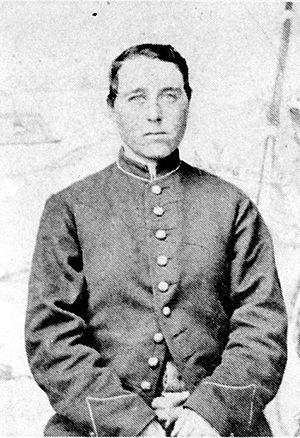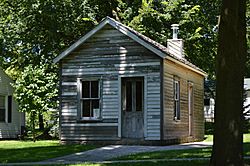Albert Cashier facts for kids
Quick facts for kids
Albert D. J. Cashier
|
|
|---|---|

(November, 1864)
|
|
| Birth name | Jennie Irene Hodgers |
| Born | December 25, 1843 Clogherhead, County Louth, Ireland |
| Died | October 10, 1915 (aged 71) Saunemin, Illinois, U.S. |
| Buried |
Saunemin, Illinois, U.S.
|
| Allegiance | |
| Service/ |
|
| Years of service | 1862–1865 |
| Rank | Private |
| Unit | 95th Illinois Infantry, Company G |
| Battles/wars | Vicksburg, Red River, Guntown |
| Other work | Cemetery worker, janitor, lamplighter |
Albert D. J. Cashier (born Jennie Irene Hodgers on December 25, 1843 – died October 10, 1915) was a soldier who fought for the Union Army during the American Civil War. Albert Cashier lived as a man for more than 50 years, starting before joining the army and continuing until death. This long commitment to living as a man has led some historians to suggest that Cashier was a trans man. Cashier is known as one of many women who served as men in the Civil War.
Contents
Early Life and Moving to America
Albert Cashier was born Jennie Hodgers in Clogherhead, County Louth, Ireland, on December 25, 1843. Cashier's parents were Sallie and Patrick Hodgers.
Before the war, Jennie Hodgers began living as Albert Cashier. This allowed Cashier to find work and live independently. It is believed that Cashier traveled to the United States as a stowaway. By 1862, Cashier was working as a farmhand in Belvidere, Illinois.
Joining the Army
In July 1862, President Abraham Lincoln asked for more soldiers to join the Union Army. Albert Cashier answered this call.
On August 6, 1862, at age 18, Cashier joined the 95th Illinois Infantry. Cashier signed up for three years of service under the name "Albert D.J. Cashier." Cashier was placed in Company G. Army records listed Cashier as 19 years old and small in size.
Many soldiers from Belvidere had already fought in battles like the Battle of Shiloh. Cashier traveled by train to Rockford to enlist. Cashier and other new soldiers learned how to be infantrymen at Camp Fuller. The 95th Regiment then traveled by ship and train to Confederate areas in Kentucky and Tennessee. They became part of the Army of the Tennessee under General Ulysses S. Grant.
Serving in the War
The 95th Illinois Infantry, part of General Grant's army, fought in about 40 battles. One major battle was the Siege of Vicksburg. During this siege, Cashier was captured while scouting ahead. However, Cashier managed to escape and return to the regiment.
In June 1863, while the siege was still happening, Cashier became sick and went to a military hospital. Cashier managed to keep the secret of being assigned female at birth hidden.
In the spring of 1864, the regiment was part of the Red River campaign. They also fought in June 1864 at the Battle of Brice's Cross Roads in Guntown, Mississippi. The regiment lost many soldiers in this battle.
After recovering, the 95th Regiment fought again in the winter of 1864. They took part in the Franklin–Nashville campaign. This included battles at Spring Hill, Franklin, and the defense of Nashville.
During the war, the regiment traveled about 9,000 miles. Other soldiers noticed Cashier was small and preferred to be alone. These traits were not unusual for soldiers. Cashier fought throughout the war and was honorably discharged on August 17, 1865. All the soldiers were officially released from duty that day.
Albert Cashier was one of at least 250 people assigned female at birth who joined the Civil War as men.
Life After the War

After the war, Albert Cashier returned to Belvidere, Illinois for a short time. Cashier continued to live as a man. In 1869, Cashier moved to Saunemin, Illinois. There, Cashier worked as a farmhand and did other small jobs around town. Cashier's name can be found in the town's work records.
For a while, Cashier lived with the Chesbro family in exchange for work. Later, a small house was built for Cashier in 1885. For over 40 years, Cashier lived in Saunemin. Cashier worked as a church janitor, a cemetery worker, and a street lamplighter. Living as a man allowed Cashier to vote in elections. It also allowed Cashier to receive a veteran's pension later on. Pension payments started in 1907.
In later years, Cashier often ate meals with the neighboring Lannon family. The Lannons discovered Cashier's secret when Cashier became ill. However, they decided to keep it private.
In 1911, Cashier was hit by a car driven by State Senator Ira Lish. This accident resulted in a broken leg. A doctor at the hospital discovered Cashier's secret but also kept it quiet. Because Cashier could no longer work, Cashier moved to the Soldiers and Sailors home in Quincy, Illinois, on May 5, 1911. Many friends and former soldiers from the 95th Regiment visited Cashier there.
In March 1914, Cashier's mental health began to decline. Cashier was moved to the Watertown State Hospital for the Insane in East Moline, Illinois. Attendants at the hospital discovered Cashier's secret. Cashier was then made to wear women's clothes again after more than 50 years of living as a man. In 1914, the veterans' pension board investigated Cashier for possible fraud. However, former comrades confirmed that Cashier was indeed the soldier who fought in the Civil War. In February 1915, the board decided that pension payments should continue for Cashier's lifetime.
Death and Remembrance
Albert Cashier passed away on October 10, 1915. Cashier was buried in a military uniform. The tombstone reads "Albert D. J. Cashier, Co. G, 95 Ill. Inf." Cashier received a full military funeral service from the Grand Army of the Republic.
It took nine years for W.J. Singleton, who was in charge of Cashier's estate, to find out Cashier's birth name, Jennie Hodgers. No one was able to prove they were a rightful heir. The money from the estate, about $282 after funeral costs, was given to the Adams County, Illinois, treasury. In the 1970s, a second tombstone was placed next to the first one at Sunny Slope cemetery in Saunemin, Illinois. This new stone has both names: Albert D. J. Cashier and Jennie Hodgers.
Cashier's name is listed on a wall inside the Illinois memorial at Vicksburg National Military Park.
A musical called The Civility of Albert Cashier has been created about Cashier's life. The Chicago Tribune newspaper called it "A timely musical about a trans soldier."
Other books about Cashier's life include Also Known As Albert D. J. Cashier: The Jennie Hodgers Story by Lon P. Dawson and the novel My Last Skirt by Lynda Durrant. Cashier was also mentioned in a collection of essays called Nine Irish Lives. In 2022, Michael Leali wrote a young adult novel called The Civil War of Amos Abernathy, where Cashier is a penpal.
Cashier's house in Saunemin has been restored.
Some authors and scholars believe that Albert Cashier was a trans man. They base this on the fact that Cashier lived as a man for over 50 years.
Images for kids
See also
 In Spanish: Albert Cashier para niños
In Spanish: Albert Cashier para niños



